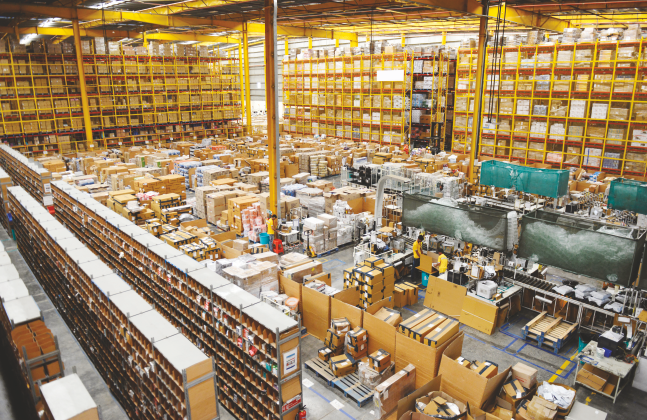DECODING WAREHOUSING BOOM IN BHIWANDI AND PANVEL
Sky-high land price in Mumbai makes it unviable for warehousing. This makes the nearest pockets Bhiwandi and Panvel the most suitable alternatives to serve the mega city, but is the boom sustainable?
If you are an avid online shopper then there are great chances that you must have come across the name of Bhiwandi while keeping a track of your shipment. Not just ecommerce, Bhiwandi is also a vital cord in the supply chain network for bunch of consumer goods companies. Panvel is another name that closely matches Bhiwandi as far as logistics and supply chain business is concerned. Located closer to the financial capital of India, and the advantage of having access to a very well connected highway network and one of India’s biggest container ports at Nhava Sheva, Bhiwandi and Panvel have the advantage that rarely any other warehousing and distribution hub in India can match. Apart from strategic location, while both the places have very lucrative real estate rates that attract the warehousing boom at these places but over a period of time the prices have shot up and now it is dotted with a large number of warehouses. With the implementation of two major reforms in the form of GST followed by e-way bill, investments in logistics sector is on a never seen before growth curve, and Bhiwandi and Panvel are now getting stiff competition from places like Pune, to retain its position as the top cargo fulfillment hub.
Advantages
 One of the biggest factors which works in favour of these two suburbs of Mumbai is proximity to Nhava Sheva. Since the port acts as a gateway for more than 60 per cent of imports in the country, most of the companies prefer to set up their warehousing hub in and around the area. Highlighting the advantages for the cargo hubs, Ryan Oliver, Business Head – Contract Logistics, Agility explains that due to its close proximity to the port, Panvel predominantly became more sought after for a CFS warehousing model business with fragmented Domestic Tariff Area (DTA) distribution centers. Over the last 15-20 years, with increasing demand and lower cost of real estate, the focus gradually shifted to Bhiwandi for DTA movements and warehouse consolidation.
One of the biggest factors which works in favour of these two suburbs of Mumbai is proximity to Nhava Sheva. Since the port acts as a gateway for more than 60 per cent of imports in the country, most of the companies prefer to set up their warehousing hub in and around the area. Highlighting the advantages for the cargo hubs, Ryan Oliver, Business Head – Contract Logistics, Agility explains that due to its close proximity to the port, Panvel predominantly became more sought after for a CFS warehousing model business with fragmented Domestic Tariff Area (DTA) distribution centers. Over the last 15-20 years, with increasing demand and lower cost of real estate, the focus gradually shifted to Bhiwandi for DTA movements and warehouse consolidation.
Being the fourth most populous city in the world and the financial nerve centre of India, Mumbai is a key market for the success of company that wants to make a strong foot print in India. However, at the same time real estate price in Mumbai is one of the highest not in India but it is at par with any metropolitan in the west. In such a scenario it is difficult to acquire large land parcels in Mumbai to serve the region. As a result, Bhiwandi gradually grew as the most suitable location to serve as the warehousing and distribution hub. Gradually due to availability of land parcels, competitive cost of construction and lower cost of labor allowed developers to create warehousing facilities.
 Apart from the hard infrastructure there are a set of eco-systems which helped Bhiwandi warehousing sector to grow by leaps and bound. Vikas Anand, Managing Director, DHL stresses that Bhiwandi has very less issues related to industrial relation and other factors like labour unrest. Local farmers in the area have come forward to enter into joint ventures with warehouse builders, unlike other locations. Warehouse rentals are also competitive in Bhiwandi and there is a vast option to choose from due to high availability. Due to this reason several investment companies have invested in the Bhiwandi belt.
Apart from the hard infrastructure there are a set of eco-systems which helped Bhiwandi warehousing sector to grow by leaps and bound. Vikas Anand, Managing Director, DHL stresses that Bhiwandi has very less issues related to industrial relation and other factors like labour unrest. Local farmers in the area have come forward to enter into joint ventures with warehouse builders, unlike other locations. Warehouse rentals are also competitive in Bhiwandi and there is a vast option to choose from due to high availability. Due to this reason several investment companies have invested in the Bhiwandi belt.
 Will the growth momentum continue! Customers are very sensitive to rentals, thus warehousing clusters that are in a position to offer affordable space would enjoy a competitive advantage over others. Gautam Dembla, Director, Spear Logistics observes that with warehouse rentals in the range of `14-22 per sqft/month in Bhiwandi, rentals are significantly attractive in comparison to competing warehousing hubs like Panvel, that commands higher rentals of `20-28 per sqft/month.
Will the growth momentum continue! Customers are very sensitive to rentals, thus warehousing clusters that are in a position to offer affordable space would enjoy a competitive advantage over others. Gautam Dembla, Director, Spear Logistics observes that with warehouse rentals in the range of `14-22 per sqft/month in Bhiwandi, rentals are significantly attractive in comparison to competing warehousing hubs like Panvel, that commands higher rentals of `20-28 per sqft/month.
Due to huge spurt of demand in Bhiwandi post-GST, there was shortage of large ready to move in warehouses, however as a large quantum of land is available on Nashik road, rentals will continue to remain affordable for clients who are ready to wait. However, identifying warehouse with a clear land title is a big challenge in Bhiwandi. On account of tiny and scattered land holdings in the hands of several villagers, identifying a contiguous land parcel of the relevant size for warehouse development is a challenge.
 Due to inflow of new entrants the real estate prices at Bhiwandi and Panvel have shot up however, the demand for warehousing space at these locations have not subdued. Explaining the reason for the steady demand, Anshul Singhal, CEO and Director, Embassy Industrial Parks explains that displacement demand is very strong in Bhiwandi region, due to clients moving away from Grade C non-compliant sheds to legal Grade A warehouses. Bhiwandi and Panvel have historically been served by non-compliant individual sheds offering low specifications. There is massive demand for Grade A and legally compliant world class warehouses. Displacement demand is coupled by increasing consumption in Mumbai Metropolitan region. This is creating massive demand from E-commerce and FMCG companies for additional warehousing spaces.
Due to inflow of new entrants the real estate prices at Bhiwandi and Panvel have shot up however, the demand for warehousing space at these locations have not subdued. Explaining the reason for the steady demand, Anshul Singhal, CEO and Director, Embassy Industrial Parks explains that displacement demand is very strong in Bhiwandi region, due to clients moving away from Grade C non-compliant sheds to legal Grade A warehouses. Bhiwandi and Panvel have historically been served by non-compliant individual sheds offering low specifications. There is massive demand for Grade A and legally compliant world class warehouses. Displacement demand is coupled by increasing consumption in Mumbai Metropolitan region. This is creating massive demand from E-commerce and FMCG companies for additional warehousing spaces.
With the increased need for warehousing at Bhiwandi and Panvel, there is rise in employment and the resultant demand for residential complexes which has fuelled real estate price rise. The huge gap between customer low price expectations and the high cost of rentals borne by service providers, has driven margins down and makes business challenging and sometimes unsustainable for most operators at this juncture.
The Way Forward
 Industry insiders believe that the warehousing market of Bhiwandi and Panvel will continue to grow in the future as well. Chander Agarwal, MD, TCIEXPRESS observes that Bhiwandi apart from the infrastructure developments like the proposed sixlane Trans Harbour Link connecting South Mumbai to Nhava Sheva, the upcoming new International Airport in Ulwe, the Mumbai Integrated SEZ at Khopate in Uran, and expansion of JNPT will combine and fuel the express logistics’ domain in these areas.
Industry insiders believe that the warehousing market of Bhiwandi and Panvel will continue to grow in the future as well. Chander Agarwal, MD, TCIEXPRESS observes that Bhiwandi apart from the infrastructure developments like the proposed sixlane Trans Harbour Link connecting South Mumbai to Nhava Sheva, the upcoming new International Airport in Ulwe, the Mumbai Integrated SEZ at Khopate in Uran, and expansion of JNPT will combine and fuel the express logistics’ domain in these areas.
However, industries such as FMCG and Pharma, aftermarket sales etc whose USP is nearness to customer, continue to face the dilemma of either continuing with their existing larger warehouse network or opt for consolidation. Since the consolidation of warehouses has a direct impact on longer lead times to reach point of sale and consumption, as well as a substantial increase in transportation costs.
A majority of the warehousing requirement comes from manufacturing sector is fulfilled by captive space, either in terms of space at the manufacturer’s plant or company-owned warehouses. In contrast, the consumption- led warehouse requirement is close to urban agglomerations and thus in leased premises close to such urban centres. Projects like the proposed Mumbai-Nagpur expressway will further fuel next wave of warehousing projects in Bhiwandi. Currently, the existing highway is becoming a choke point though. Apart from the accessibility being an advantage, Bhiwandi and Panvel also offer affordable land and labour, which also contributes in the efficiency by which the warehouses operate in.







